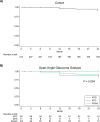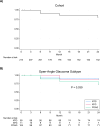Two-Year Post-Market Surveillance of iStent inject ® W Combined with Phacoemulsification in Japanese Open-Angle Glaucoma Eyes
- PMID: 40529114
- PMCID: PMC12170447
- DOI: 10.2147/OPTH.S524956
Two-Year Post-Market Surveillance of iStent inject ® W Combined with Phacoemulsification in Japanese Open-Angle Glaucoma Eyes
Abstract
Purpose: To evaluate 2-year safety and effectiveness of iStent inject ® W implantation with phacoemulsification in adult Japanese open-angle glaucoma (OAG) patients.
Design: Multicenter, prospective, post-market surveillance.
Methods: Eyes were evaluated preoperatively and at Day 1, Week 1, and Months (M) 1, 3, 6, 12, and 24. Primary outcome was M24 cumulative probability of success defined as no additional glaucoma surgery and intraocular pressure (IOP) < preoperative value and number of glaucoma medications ≤ preoperative value or IOP ≤ preoperative value and number of glaucoma medications < preoperative value. Other endpoints included cumulative probability of achieving American Academy of Ophthalmology Glaucoma (AAO) success criteria for minimally invasive glaucoma surgery with phacoemulsification, and changes in mean IOP, number of glaucoma medications, and medication costs over time. Subanalysis was based on OAG subtype [primary open-angle glaucoma (POAG), normal tension glaucoma (NTG), and exfoliative glaucoma (XFG)]. Adverse events were recorded.
Results: Cumulative probability of success at M24 was 91.7%, 98.8%, 88.9%, and 85.0% for cohort (N = 214), NTG, XFG, and POAG, respectively. The AAO M24 success was 80.7%. Statistically significant reductions in mean IOP and number of medications were observed through M24 in cohort and OAG subtypes. At M24, the estimated reductions in mean (standard error) IOP and number of medications were 2.0 (0.5) mmHg and 1.9 (0.4), respectively, in the cohort. Adverse events were minimal. At M24, the average monthly glaucoma medication costs decreased by 49.7%.
Conclusion: Japanese OAG eyes treated with iStent inject W combined with phacoemulsification experienced reduced IOP and medication burden with minimal adverse events and high success rates over postoperative 2 years.
Keywords: Japan; minimally invasive glaucoma surgery; trabecular micro-bypass.
© 2025 Inatani et al.
Conflict of interest statement
Masaru Inatani receives lecture fees and honorarium from Glaukos Japan. Ichiro Kohama is an employee of Glaukos Japan. Alice Chu is an employee of Glaukos Singapore and shareholder of Glaukos Corporation.
Figures




Similar articles
-
Short-Term Efficacy and Safety of Phacoemulsification Associated With iStent Inject W in Patients With Controlled Open Angle Glaucoma.J Glaucoma. 2023 Dec 1;32(12):1052-1057. doi: 10.1097/IJG.0000000000002327. Epub 2023 Oct 19. J Glaucoma. 2023. PMID: 37974323
-
Outcomes of iStent inject combined with cataract surgery in Asian eyes: Australian data from the Fight Glaucoma Blindness international registry.Int Ophthalmol. 2024 Apr 25;44(1):200. doi: 10.1007/s10792-024-03104-x. Int Ophthalmol. 2024. PMID: 38662305 Free PMC article.
-
Minimally invasive glaucoma surgery: comparison of Hydrus microstent with iStent inject in primary open-angle glaucoma.BMJ Open Ophthalmol. 2025 Feb 13;10(1):e001946. doi: 10.1136/bmjophth-2024-001946. BMJ Open Ophthalmol. 2025. PMID: 39947711 Free PMC article.
-
Standalone iStent Trabecular Micro-bypass Glaucoma Surgery: A Systematic Review and Meta-Analysis.J Glaucoma. 2021 Jul 1;30(7):606-620. doi: 10.1097/IJG.0000000000001805. J Glaucoma. 2021. PMID: 33596009
-
Ab interno trabecular bypass surgery with Schlemm´s canal microstent (Hydrus) for open angle glaucoma.Cochrane Database Syst Rev. 2020 Mar 9;3(3):CD012740. doi: 10.1002/14651858.CD012740.pub2. Cochrane Database Syst Rev. 2020. PMID: 32147807 Free PMC article.
References
LinkOut - more resources
Full Text Sources

